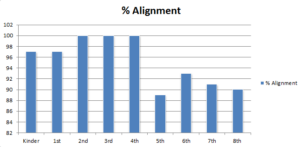When selecting materials for a campus, there are many benefits to choosing a publisher’s material that spans multiple grade levels. The consistency of navigation, layout of the instruction, technology specifications (for online materials), special population student support, and common professional development are significant considerations that may lead you to lean in favor of adopting a single material for multiple grade levels.
You may also presume that the product’s alignment to the standards will be consistent across grade levels. Not so. Having analyzed the alignment of thousands of K-8 materials, Learning List has found that the alignment percentage of a material in one grade level is not predictive of the same material’s alignment in other grade levels. Take for example, the alignment of the multi-grade level material shown in the chart below. Learning List’s alignment reports for grades K through 8th highlight a significant variation in percentage of state standards addressed by material in each grade level.
 So, what does this mean for your materials selection strategy? When you are reviewing a material to purchase for a grade span, it is critical to carefully examine the alignment of the material in each grade level. Learning List’s alignment reports make it easy to see which standards are and which are not addressed in each grade level.
So, what does this mean for your materials selection strategy? When you are reviewing a material to purchase for a grade span, it is critical to carefully examine the alignment of the material in each grade level. Learning List’s alignment reports make it easy to see which standards are and which are not addressed in each grade level.
If a comprehensive material is not aligned to 100% of the standards in each grade level, determine whether there is a pattern in the standards that are not addressed across all grade levels. For example, does this material simply not address the financial literacy standards in each grade level? If so, then it is easier to identify other materials that will fill in the gap for this product at all grade levels.
If there is no obvious pattern in the material’s alignment across grade levels, then the variability may be caused by the fact that different authors wrote each grade level or different people correlated the material at each grade level. Finding products to fill in the material’s gaps will be more arduous and more expensive, though Learning List’s Fill-in-the-Gap tool and new Search by Standard filter lessens that burden.
This revelation should not necessarily be discouraging. As one superintendent told me, “Realizing that a material is not necessarily aligned consistently across all grade levels was a real ‘A-Ha’ moment for me. I no longer had to force all my teachers to agree on a single material. This year, we adopted one product for the elementary grades and another for the middle schools. The teachers were much happier. Now my technology staff… well, that’s another story.”